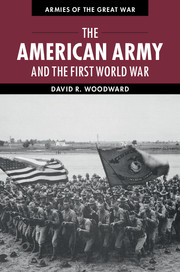Book contents
- Frontmatter
- Dedication
- Contents
- List of figures
- List of maps
- List of tables
- Preface
- List of abbreviations
- Introduction
- 1 Birth of a modern army
- 2 World war and American preparedness
- 3 Coercive power and Wilsonian diplomacy
- 4 “You’re in the army now”
- 5 US army doctrine and industrialized trench warfare
- 6 Over where?
- 7 American Expeditionary Force organization, overseas training, and deployment
- 8 Will the Americans arrive in time?
- 9 Failed expectations: “the military establishment of the United States has fallen down”
- 10 Atlantic ferry
- 11 Neck of the bottle
- 12 Uncertain times
- 13 Cantigny
- 14 Into the breach
- 15 American soldiers in north Russia and Siberia
- 16 The beginning of the end
- 17 Establishment of the American First Army and Saint-Mihiel
- 18 Meuse-Argonne, September 26–October 31
- 19 Breakout, November 1–11
- 20 Epilogue
- Notes
- Bibliography
- Index
Preface
Published online by Cambridge University Press: 05 July 2014
- Frontmatter
- Dedication
- Contents
- List of figures
- List of maps
- List of tables
- Preface
- List of abbreviations
- Introduction
- 1 Birth of a modern army
- 2 World war and American preparedness
- 3 Coercive power and Wilsonian diplomacy
- 4 “You’re in the army now”
- 5 US army doctrine and industrialized trench warfare
- 6 Over where?
- 7 American Expeditionary Force organization, overseas training, and deployment
- 8 Will the Americans arrive in time?
- 9 Failed expectations: “the military establishment of the United States has fallen down”
- 10 Atlantic ferry
- 11 Neck of the bottle
- 12 Uncertain times
- 13 Cantigny
- 14 Into the breach
- 15 American soldiers in north Russia and Siberia
- 16 The beginning of the end
- 17 Establishment of the American First Army and Saint-Mihiel
- 18 Meuse-Argonne, September 26–October 31
- 19 Breakout, November 1–11
- 20 Epilogue
- Notes
- Bibliography
- Index
Summary
My commander-in-chief, Michael Watson, the capable and patient military history editor for Cambridge University Press, presented me with a formidable objective in late 2010: write a holistic history of the US Army’s role in World War I that examined diverse social, political, diplomatic, and military themes. At times during the past two years I have felt as if I were one of Pershing’s Doughboys attempting to navigate the unfamiliar and intricate German defenses at Meuse-Argonne. Indeed, their persistence was required to achieve my assigned mission.
Once the United States becomes a belligerent I address multiple themes, including the raising, training, transporting, and logistical support of a diverse force which included African and Native Americans as well as many other hyphenated Americans, coalition warfare (a new experience for the US military and political leadership), failures in war production, the interdependence of armed force and diplomacy, armed intervention in Russia, and the creation of an independent US force with its own strategical objectives. Although this narrative with its emphasis on leaders such as Pershing and Wilson generally embraces a top-down rather than a bottom-up approach, ordinary American soldiers are given their due by including their voices through the use of letters, memoirs, and other personal accounts. Finally, by placing the American Expeditionary Force’s role within the larger war, I avoid examining American participation exclusively from a US perspective.
- Type
- Chapter
- Information
- The American Army and the First World War , pp. xv - xviPublisher: Cambridge University PressPrint publication year: 2014

